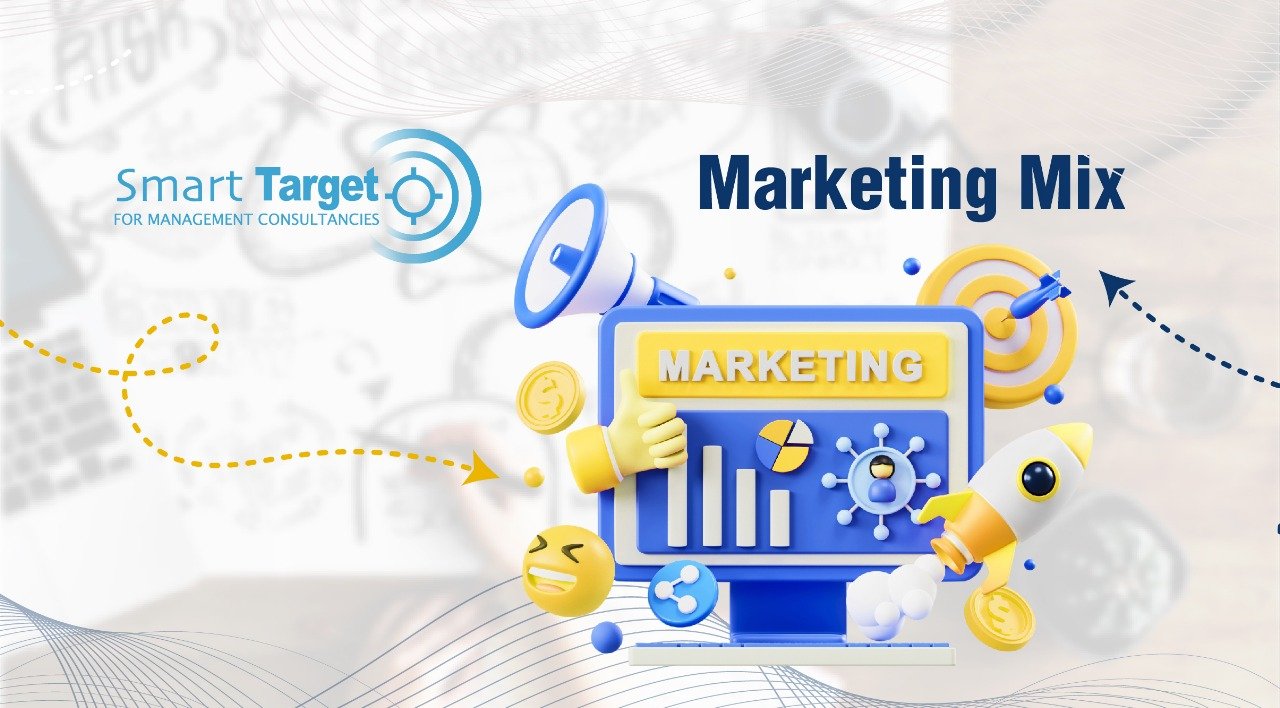Marketing Mix
The marketing mix is an essential tool for the success of any company.
By understanding the components of the marketing mix and using them effectively, companies can achieve their marketing goals, build strong relationships with customers, and achieve success in the market.
The marketing mix is one of the most important tools that helps companies form a successful marketing strategy
What is the definition of marketing mix?
The marketing mix is defined as a set of elements that a company controls to create a value proposition to customers. These elements are known as the seven Ps, and they are:
- Product Product.
- Price Price.
- Place.
- Promotion.
- People.
- Process.
- Physical Evidence.
What is the importance of relying on the Marketing Mix strategy?
Relying on the marketing mix strategy helps achieve many benefits, including:
- Understanding customer needs: By analyzing the market and customers, their needs and desires can be better identified, and thus
- developing products and services that meet those needs.
- Competitiveness: It helps to stand out from competitors by providing a unique value proposition.
- Achieving objectives: By using the marketing mix effectively, marketing objectives can be achieved, such as increasing sales or
- expanding market share.
What are the characteristics of the marketing mix?
The marketing mix is characterized by several characteristics, the most prominent of which are:
- Integration: The elements of the marketing mix must be integrated with each other to form a cohesive value proposition.
- Adaptation: The elements of the marketing mix must be modified periodically to adapt to changes in the market and customer needs.
- Flexibility: the ability to quickly change elements of the marketing mix to meet changing customer needs.
What are the objectives of the marketing mix? Or what is the purpose of the marketing mix?
The marketing mix strategy aims to achieve many objectives, such as:
- Increase sales: By offering products and services that meet customer needs, sales can be increased.
- Expanding market share: By standing out from competitors, companies and individuals can expand their market share.
- Improving brand image: By providing a cohesive value proposition, its brand image can be improved.
- Creating customer loyalty: by effectively meeting customer needs.
Explaining the elements of the marketing mix (the 7p’s)
The marketing mix, also known as the 7P's, is a set of components or elements that are used to create an integrated marketing strategy.
Which:
1.Product
The product is the basic element in the marketing mix. The company should focus on developing products that meet customers' needs and wants. The company must also consider the quality, design and features of the product.
2. Price
One of the most important factors affecting the decision to purchase a product.
The company must set an appropriate price for its products that makes it profitable and meets customer needs.
3. Place
Place refers to the distribution channels used to get the product to customers, and how efficient they are, compared to competitors.
4. Promotion
Activities carried out by the company to inform customers about its products or services.
5. People
The company's employees who deal with customers, what their experience is, and the level of customer service.
6. Process
The procedures followed by the company to provide its products or services, and their efficiency.
7. Physical Evidence
Everything customers can see, touch or feel about a company's products or services. Such as product packaging or design.
Interaction between the components of the marketing mix
The components of the marketing mix interact interconnectedly to ensure the success of the marketing plan. For example, the product must be well designed and marketable, priced appropriately for the target market, distributed through effective distribution channels, and promoted appropriately to ensure it reaches the target customers.
Types of marketing mix
There are different types of marketing mix, the most prominent of which are:
- Merchandise marketing mix: Focuses on the physical characteristics of the product, such as quality, design, and packaging.
- Services marketing mix: Focuses on the intangible aspects of service, such as employee efficiency and speed of service.
- Marketing mix for consumer goods: Focuses on attracting consumers through advertising and promotion.
- Marketing mix for industrial goods: Focuses on building relationships with other companies.
Examples of marketing mix
One of the most famous examples of the marketing mix is the marketing mix
McDonald's is a strong and powerful company based on the four basic elements of marketing:
- Product: McDonald's offers a variety of fast food, such as burgers, French fries, and soft drinks.
- Price: McDonald's offers competitive prices that suit all categories.
- Location: McDonald's has branches all over the world, making it easily accessible.
- Promotion: McDonald's uses various advertising and promotional methods, such as television ads, print ads, and marketing events.
Marketing mix strategy
Companies must follow a clear strategy when using the marketing mix. Which includes some main steps:
- Determine the target market
- Competition analysis
- Determine marketing objectives
- Design the marketing mix based on the needs of the target market, competition analysis, and marketing objectives.
- Evaluate the marketing mix periodically and make the necessary adjustments.
Promotional mix (the 4Ps)
The promotional mix is one of the most important elements of the marketing mix. The promotional mix consists of 4 basic elements:
- Advertising: includes all activities aimed at attracting customers' attention and informing them about the company's products or services.
- Public relations: includes all activities aimed at building positive relationships with various audiences, such as customers, employees, and the community.
- Direct marketing: includes all activities aimed at communicating with customers directly, such as e-mail and SMS.
- Retailing: includes all activities aimed at selling the company's products or services to customers.

